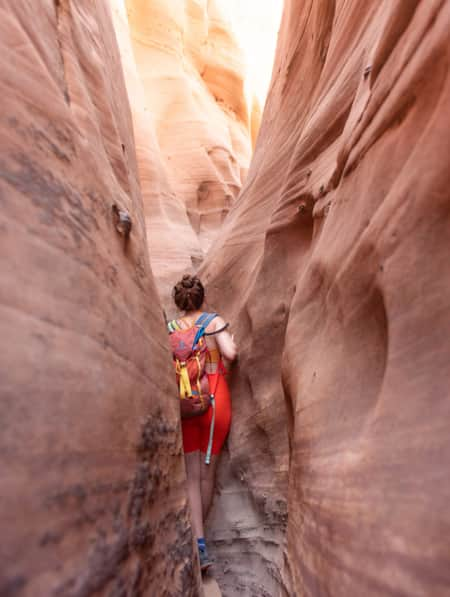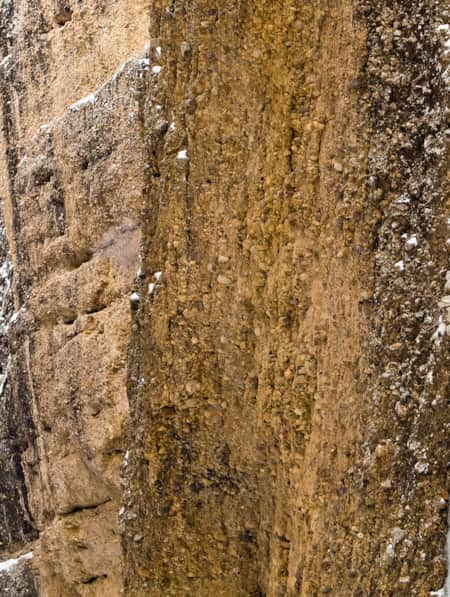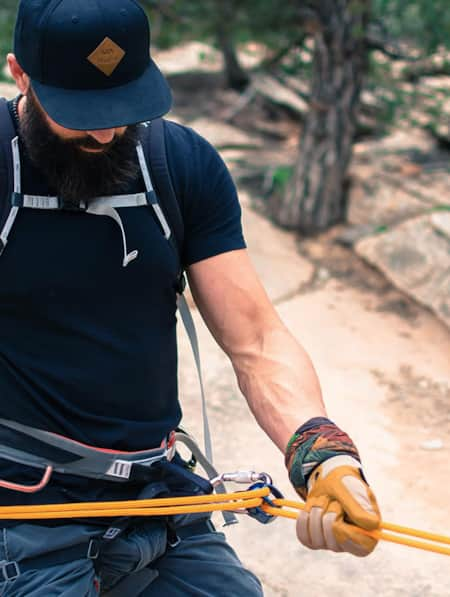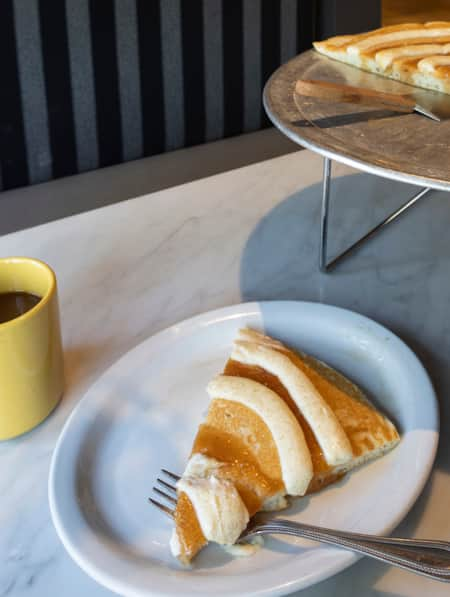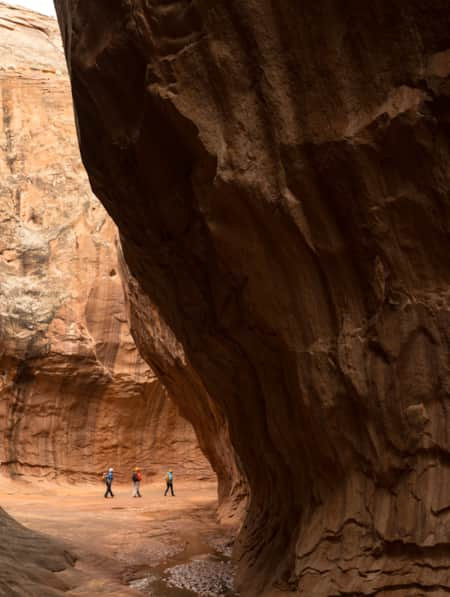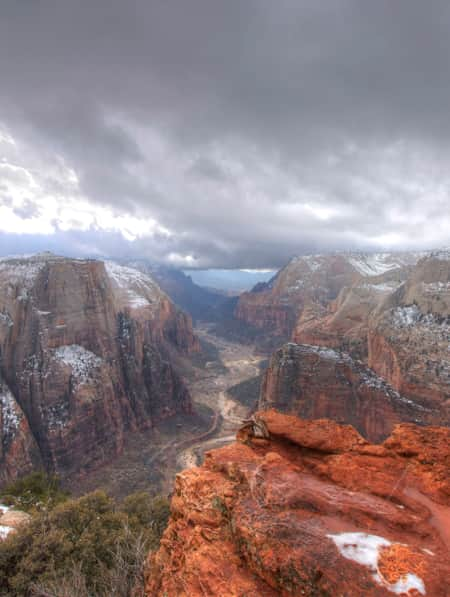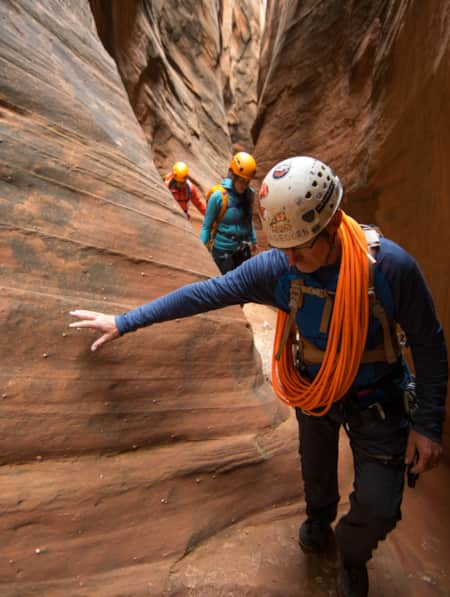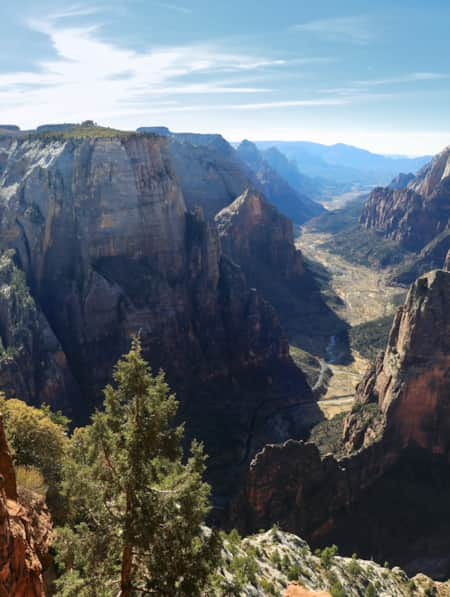Where to Climb Near Salt Lake
From Maple Canyon to Logan Canyon and spots in between, explore Northern Utah’s rock climbing legacy and iconic routes to add to your adventure itinerary.

It’s 1988 and all eyes in the climbing community are focused on Utah’s Little Cottonwood Canyon for the first-ever International Sport Climbing Championship. Across two days in June, climbers from around the world are set to test themselves on the artificial holds bolted to the side of the Snowbird’s luxury Cliff Lodge, vying for the title and $17,000 in prize money. Simultaneously, and unbeknownst to the world at large, a scrappy band of local climbers is hoisting ladders and hammer drills in the shade of a nearby cave. Playing an entirely different game, they’re pushing the future of climbing far beyond the fiberglass holds bolted to the walls of the Cliff Lodge.
Utah's Climbing Legacy
Hell Cave, in American Fork Canyon, is a small knot of suspect rock — steep and polished. Notoriously difficult, it has beckoned the heartiest sport climbers since its climbing conception in 1988. Jeff Pedersen, Boone Speed, Dave Bell, and a handful of others had a vision. The cave featured obvious holds and climbing it made sense. But nothing that steep had ever been established. Thankfully, the cave is small and the roof accessible, so relying on ladders to clean and bolt, they established the Burning route (5.13b) to coincide with the convergence of the Snowbird climbing competition and the world‘s strongest sport climbers. While the difficult grade had long been established, the angle had not. The first of its kind, Burning opened the eyes of everyone present and changed the face of climbing forever. The Red River Gorge, the Coliseum of the New River Gorge, Rifle, Maple Canyon, Kalymnos — Hell Cave and Burning started it all.
But Burning wasn’t the true beginning. Rock climbing has been a part of Utah since well before its statehood. Ancient indigenous sites showcase evidence of technical climbing, with remnants of chipped footholds used to ascend and descend many of Utah’s sandstone slots.
More recently in 1949, Harold Goodro put up the Big Cottonwood classic Goodro’s Wall. Ted Wilson — who was mayor of Salt Lake City from 1976 to 1985 — and the Alpenbock Club have been establishing climbing routes in Big Cottonwood and beyond since the 1950s, with Wilson establishing the first route in Little Cottonwood Canyon, Chicken Head Holiday, after climbing with Yvon Chounard in the Tetons in 1960. And 1976 introduced the land of splitter sandstone cracks with Earl Wiggins' ascent of Luxury Liner (now known as the uber classic Supercrack of the Desert) in Indian Creek. Step forward a few years and that scrappy granite canyon outside Salt Lake City was being pushed on the daily by the likes of Merril Bitter, Mugs Stump, Drew Bedford, the Ruckman’s, and Gordon Douglas. Rediscovered in the 90s as a prime bouldering location, Little Cottonwood draws international attention to this day.

Few places so near to an urban area are so rich in diversity. The granite cliffs are a paradise for both rock climbers and the mountain goats you might see as you drive the byway.

Just east of Salt Lake City is some of the best climbing in the country, with quartzite climbs in Big Cottonwood Canyon, and granite climbs in Little Cottonwood Canyon.
"Rock climbing has been a part of Utah since well before its statehood. Ancient indigenous sites showcase evidence of technical climbing, with remnants of chipped footholds used to ascend and descend many of Utah’s sandstone slots."
– Jeremiah Watt
Salt Lake's Climbing Evolution
The latest phenomenon in Utah climbing is actually unfolding inside. Modern climbing gyms, where one can climb on indoor walls sprouting holds sculpted from fiberglass and resin, were hard to find 15 years ago. Now Salt Lake City boasts one of the largest concentrations of world-class climbing gyms in the world, with eight locations within a 90-minute radius. In fact, Salt Lake City’s The Front Climbing Club is on track to create one of the largest climbing gyms in the world with the expansion of its original location in central Salt Lake. Even outdoor retail and experiences company, evo, has joined in, opening its first evo-branded hotel in Salt Lake City, complete with a 26,000-square foot climbing gym and fitness center. Offering everything from basic to advanced instruction and the gear to go with it, these gyms are a great place to learn the basics.
This combination of world-class outdoor routes and indoor gyms, coupled with an award-winning international airport and Delta hub status, has drawn the attention of USA Climbing.
Currently headquartered in a Salt Lake warehouse off I-15, USA Climbing has plans for a more permanent national headquarters, training center and gym to support the national team, which has included Olympians and Utah locals Nathaniel Coleman and Kyra Condie. Just as impressive, this ideal combination of training potential and location has drawn two World Cup climbing events to downtown Salt Lake. Doubly impressive, as these events are the only World Cup events held in the United States. Drawing both competitors and spectators from around the world, the World Cup is an international event worthy of the same drama as the Olympics.
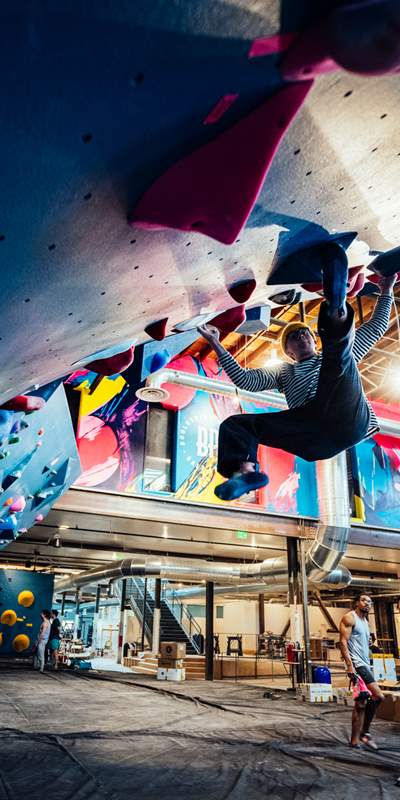
Rock Climbing Near Salt Lake
So just where does one venture if they’re looking to take advantage of all the world-class climbing that Northern Utah has to offer? We’ve narrowed it down to five areas within easy access of Salt Lake City International Airport.
The Cottonwood Canyons
Big Cottonwood Canyon is the closest to downtown Salt Lake, with a casual 15-minute drive. Big offers everything from roadside multi-pitch traditional routes to single-pitch bolted lines and everything in between on metamorphic quartzite. Classics include the three-pitch Steort’s Ridge at 5.6 and Goodro’s Wall at 5.10c.
Just a few minutes south is Little Cottonwood Canyon. The climbing here is more concentrated than in Big, but there’s just as much variety plus the addition of world-class bouldering. And in 2024, the canyon became America’s first recreational climbing area to be listed in the National Register of Historical Places. Featuring fine-grained white granite (the Salt Lake Temple was quarried from here), climbing opportunities are endless regardless of season. In the winter months, south-facing walls collect heat like large solar panels, and the tech-forward climbing of slabs like The Dorsal Fin, 4 pitches, 5.10d, are in prime condition. The summer months provide shaded canyon walls and routes like PentaPitch, 5 pitches and 5.8, and Stiffler's Mom, 7 pitches and 5.11a. For those looking for a bit more challenge the Green Adjective Gully’s, Orange Crush delivers at a healthy 5.13b. The shoulder seasons provide some of the canyon’s best climbing on the endless boulders spread liberally across the canyon floor. Twisted at V4 is an excellent introduction. Alzheimers offers something a bit heartier at V8, and for the heavy hitters, Eclipse, a V12, won’t disappoint.

Massive granite boulders surround areas just off Utah State Route 210 in Little Cottonwood Canyon.

Featuring fine-grained white granite, climbing opportunities in Little Cottonwood are endless regardless of season.

A quick 15-minute drive from downtown Salt Lake City, Big Cottonwood Canyon offers climbers routes to choose from with outstanding mountain views abounding.
American Fork Canyon
Traveling south along the I-15 corridor, you’ll arrive at American Fork Canyon around 45 minutes from Salt Lake. A high-walled, limestone canyon filled with towering pines and a river running through it, American Fork hosts some of the most challenging and legendary sport climbing in the country. Burning, 5.13b, lives a short walk above the road in Hell Cave, and if that’s too easy, there’s I Scream, 5.14c, just a few feet away. If you’re looking for easier grades, you can find those across the street at the Division Wall where there’s a host of lines ranging from 5.9 to 5.12.

American Fork Canyon hosts some of the most challenging and legendary sport climbing in the country. Climbers can ascend its walls among some of Northern Utah’s top natural treasures, including stunning caverns, waterfalls, lakes and panoramic views.
Maple Canyon
One of the more unique climbing areas in the state is Maple Canyon (Read: The Lowdown on Ice Climbing in Maple Canyon). Located about 90 minutes south of Salt Lake, just beyond Nephi, Maple is a beautiful canyon filled with conglomerate sport climbing. Not as cryptic as its limestone neighbors, the climbing here is largely endurance based on larger holds and ranges from steep to completely horizontal. The Pipe Dream cave is a sight to behold and bristles with long endurance routes out the giant ceiling. The Great Feast, 5.13b, takes a direct line out the middle. The popular Minimum Wall provides options with a little less angle. And the 49 route at 5.12a is the classic here.
Ogden
Heading north of Salt Lake on the I-15, the first climb you’ll find is 45 minutes away in Ogden. Heralded as one of the top climbing towns in the U.S., Ogden offers everything from winter bouldering to sport climbing and long adventure routes within a few minutes of downtown. For a wild multi-pitch excursion try the legendary Jeff Lowe’s Macabre Wall Proper, the first 5.12 in the country. The hills above town offer world-class bouldering with problems ranging from the three-star V3, Hidden Rock Traverse, to the savage, Breaking the Wheel, V15. One can even sport climb without leaving city limits. The 9th Street crag has routes ranging from 5.6 to 5.13 with Cracked Lip, 5.11b, a local favorite.
Logan Canyon
Perhaps one of the quietest areas in Northern Utah is Logan Canyon. Located about 80 miles north of Salt Lake, and just 20 minutes outside the town of Logan, the canyon’s climbing doesn’t disappoint. The limestone canyon offers hundreds of single-pitch sport routes with offerings for everyone from the first-timer to the international crusher. Mile 385 is a great starter crag with shady routes right off the road and offers grades from 5.10 to 5.12. If you’re looking for something a bit more stimulating, the China Cave provides legendary historical routes like Super Tweak, 5.14b.

Though it’s quieter than most of Utah’s big canyons, Logan is spiderwebbed with a huge trail system, over 400 climbing routes, a handful of stunning alpine lakes and peaks that come summertime are bursting with wildflowers.

Nicknamed the “Last Unspoiled Place” by National Geographic, Logan Canyon is both the winding vein connecting Cache Valley to Bear Lake and an outdoor paradise.
Make Time to Enjoy the Local Haunts
On a recent venture to Logan Canyon, our climbing crew made a day of it with a stop in Logan. We got a solid start with a stop at Caffé Ibis, where you’ll find a mix of breakfast sandwiches and tasty treats complete with some of the finest coffee in the state. If you’re around for lunch, the Pollo Azteca food truck brings the flavor with its birria and chicken not to be missed. After a day exploring the canyon, we made a dinner stop at Prodigy Brewing Co. for craft brews, house-made salads, build-it-your-way burgers and wood-fired pizzas.
With ascents ranging from the storied to the sublime, Utah offers endless climbing potential. With fresh routes added on the daily, the opportunities to climb within a short drive of Salt Lake City make Northern Utah an ideal climbing destination.

Logan is a high mountain valley town known for outdoor adventures, strong heritage and performing arts. It has much to offer in the way of culinary experiences, including cafes and breweries.

The Pollo Azteca food truck brings the flavor with its birria and chicken not to be missed.

Prodigy Brewing Co. offers craft brews, house-made salads, build-it-your-way burgers, and wood-fired pizzas.
Tips to Climb Responsibly:
- Leave no trace. Climbing chalk can have a significant impact on dark and porous rock — don't use it around historic petroglyph and pictograph panels. Pick up litter, and leave trees and plants intact. (Read: How to Visit Rock Imagery Sites Like an Archaeologist)
- Dispose of human waste properly. Use toilets whenever possible. If they are not available, dig a "cat hole" at least six inches deep and 200 feet from any water, trails, campsites or the base of climbs. Pack out toilet paper. (Read: How to Poop in the Outdoors)
- Use existing trails. Cutting switchbacks causes erosion. When walking off trail, tread lightly, especially in the desert, where cryptobiotic soils exist.
- Drive only on established roads.
- When climbing, be discreet with fixed anchors. Bolts are controversial; don't place them unless they are absolutely necessary.
- Respect the rules, and speak up when others don't. Expect restrictions in designated wilderness areas, rock imagery sites and caves as well as to protect wildlife.
- Park and camp only in designated areas, using permits when required. Do not build fires in the backcountry.
- Respect private property. Be courteous to land owners.
- When bouldering or climbing, do not use wire brushes on stone to improve hand and footholds. Leave the rock as you found it.

Salt Lake City's distinct neighborhoods each have a unique character, and visitors can have fun discovering its eccentricities

Unlike most other metropolitan areas, Salt Lake's lush and beautiful mountains and canyons sit on the very borders of the city and offer recreation opportunities within minutes of its hustle and bustle.





